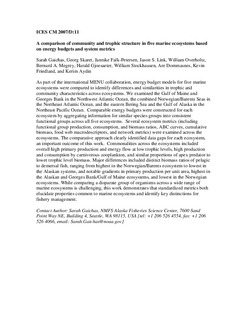| dc.description.abstract | As part of the international MENU collaboration, energy budget models for five marine ecosystems were compared to identify differences and similarities in trophic and community characteristics across ecosystems. We examined the Gulf of Maine and Georges Bank in the Northwest Atlantic Ocean, the combined Norwegian/Barents Seas in the Northeast Atlantic Ocean, and the eastern Bering Sea and the Gulf of Alaska in the Northeast Pacific Ocean. Comparable energy budgets were constructed for each ecosystem by aggregating information for similar species groups into consistent functional groups across all five ecosystems. Several ecosystem metrics (including functional group production, consumption, and biomass ratios, ABC curves, cumulative biomass, food web macrodescriptors, and network metrics) were examined across the ecosystems. The comparative approach clearly identified data gaps for each ecosystem, an important outcome of this work. Commonalities across the ecosystems included overall high primary production and energy flow at low trophic levels, high production and consumption by carnivorous zooplankton, and similar proportions of apex predator to lower trophic level biomass. Major differences included distinct biomass ratios of pelagic to demersal fish, ranging from highest in the Norwegian/Barents ecosystem to lowest in the Alaskan systems, and notable gradients in primary production per unit area, highest in the Alaskan and Georges Bank/Gulf of Maine ecosystems, and lowest in the Norwegian ecosystems. While comparing a disparate group of organisms across a wide range of marine ecosystems is challenging, this work demonstrates that standardized metrics both elucidate properties common to marine ecosystems and identify key distinctions for fishery management. | no_NO |
